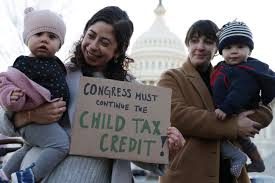
AAYUSH SINGH – OCTOBER 9TH, 2022
In January of 2022, 3.7 million children fell into poverty. It was a policy choice. A few weeks earlier, Congress had failed to renew the expanded child tax credit, the pandemic-era extension of benefits that provided parents up to $3,600 a year to help make ends meet. The benefit was a revolution in policymaking. For decades, poverty legislation has been laser-focused on work requirements and means-testing, often predicated on the myth that cash transfers would encourage joblessness and drug use.
The American Rescue Plan, President Biden’s sweeping $1.9 trillion stimulus package, seemed to mark a paradigm shift. 88% of American families in 2021 received direct aid from the federal government, with few strings attached. By the new year, it was gone, leaving a haunting question in its wake: how could a policy so generous disappear so soon?
The Child Tax Credit, A Brief History
The history of the child tax credit dates back only a few decades to 1997. As part of the Taxpayer Relief Act, Congress established a $400 credit for each child younger than seventeen years old in an attempt to provide additional economic security for families. It was nonrefundable, however, and only decreased the amount families owed to the IRS. This operated in contrast to a refundable credit, which essentially put money directly into taxpayers’ hands.
In the years since its creation, the child tax credit has undergone several alterations – lawmakers notably made it partly refundable in 2001 – but at the start of the COVID-19 pandemic, it stood at $2,000, with up to $1,400 being refundable. President Biden’s package nearly tripled the latter amount, which had huge consequences. Though Census data is not yet available for the entire year, a 2019 Columbia University study of a nearly identical proposal estimated that the expansion would reduce child poverty by 45%.
It’s hard to overstate just how much of a sea change in social policy thinking this was. In 1996 – one year before the expanded child tax credit was born – President Bill Clinton, a Democrat, signed the Personal Responsibility and Work Opportunity Act into law, a series of reforms to welfare. The legislation imposed stringent work requirements and time limits on benefits. It was an era where getting people off the welfare rolls and encouraging work was the new rallying cry in politics. Among the act’s effects: an increase in deep poverty. President Clinton’s signature legislative achievement capped federal spending and relied heavily on block grants to states, giving them wide latitude in dispersing money. States took advantage. In Arizona, for every 100 families with children in poverty, only six received aid in 2019.
But in recent years, a marked shift in welfare and policy thinking seemed to be occurring. Senate Republicans had started to come around to the idea of government assistance, in part because it seemed to promote traditional values like family stability and marriage. In the summer of 2020, a group of conservative scholars wrote that “enlarging the child credit would offer much needed relief.” Indeed, three years prior, President Trump’s tax cuts – otherwise a nightmare for liberals of handouts to corporations and the wealthy – included a child tax credit expansion. In this climate, you would think child poverty legislation may be one of the few things both sides could agree on. You would be wrong.
Politics: The Art of the Possible
On December 15th, 2021, the last payment to families went out. Congress had failed to renew the benefit, and the odds that the House and Senate will come to any sort of agreement look increasingly grim. The long-term outlook looks worse, especially because it’s likely that Democrats will lose their current trifecta in the government in this year’s midterm elections.
The principal cause of the child tax credit’s expiration is opposition from Senator Joe Manchin, one of the Senate’s most outspoken centrists. His concerns over the deficit and inflation doomed President Biden’s Build Back Better bill, of which the child tax credit was an important part. But inflation wasn’t his only hesitation. In December of 2021, The Huffington Post reported that Manchin privately told colleagues he was worried parents would abuse this kind of handout, spending the money on drugs instead. This is a concern with little basis in fact, the kind of assertion politicians often make that is divorced from reality. The difference in drug use between recipients of welfare and non-recipients is statistically insignificant, and the money spent on drug testing often exceeds the money lost on fraud. With regard to the expanded child tax credit, a study from the Center on Budget and Policy Priorities (CBPP) found that nine in ten families were spending the benefit on necessities like food, rent, and utilities.
Manchin has also expressed support for work requirements a number of times. This too lacks any empirical basis. A recent working paper published by the National Bureau of Economic Research (NBER) found that work requirements for SNAP – America’s largest food stamp program – decreased participation by 53%, with no discernible effect on employment. The negative consequences of Manchin’s comments go beyond just dollars and cents, though. When asked by reporters about his colleague’s statements, Senator Sherrod Brown responded, “I think that raising children is work.”
Senator Brown is correct. Manchin’s concerns don’t simply run counter to economic data, they also reinforce the idea – built up through centuries of sexism – that domestic labor should remain uncompensated. In 2020, an Oxfam analysis found that women’s unpaid labor in the United States was worth $1.5 trillion. As UPenn Anthropology Professor Kristen Ghodsee writes, “traditional expectations that caring for children… should be done [for free] within the family obscure the true economic value of this work.” Female-occupied spaces, such as the household, have a history of being defined as outside the scope of salaried work. Senator Manchin is not expressing those beliefs explicitly, but his demand for a work requirement all but confirms that this history is informing his views. Would he ask for such a precondition for any other form of labor?
In addition to gender stereotypes, the conversation around child welfare policy has also taken on racial undertones. The political scientist Richard Fording finds that Americans’ attitudes about those receiving welfare was heavily tied to their feelings about African-Americans. Underpinning these sentiments is the myth of the “welfare queen,” the trope of welfare mothers living lavishly that was utilized by President Ronald Reagan to drum up support for cutting government spending. At the time, 40% of welfare recipients were African-American. This dynamic illustrates a kind of perverse feedback loop: prejudiced feelings from voters partly determine who is in office; once elected, those officials then stir up racial animus and enact public policy to keep winning votes. This point – about who we deem worthy of aid, compensation, and help – is one that everyone should keep in mind when thinking about why the government allowed the expiration of the child tax credit, while it has routinely renewed tax cuts for the wealthy.
Lessons Unlearned
Turning back to the pandemic, perhaps its biggest lesson is how short our collective memories are. The response to COVID-19 demonstrated that poverty in the United States is a policy choice. The generous aid the United States doled out through the CARES Act led to a reduction in poverty in the midst of unprecedented economic turmoil. For a moment, there looked to be a genuine re-thinking of the way America did things, moving its welfare policy from complicated administrative provisions to simply giving people money. As the journalist Rachel Cohen put it in The New York Times, “the coronavirus made the radical possible.”
But our generosity does not have to be conditioned on the existence of a novel pathogen, especially in light of what we know about child poverty policy. A study that made waves a few months ago when it was published found that direct aid to poor mothers led to a noticeable increase in their babies’ brain function. Another NBER study found that providing money to low-income children with disabilities led to a 60% decrease in their crime rate. These are monumental knock-on effects, the kind of positive consequences that develop when nations make sound investments in their children. Unfortunately, the United States’s commitment to its people seems to be a relic of a bygone era.
To some extent, this is an indictment of the Democratic Party’s political approach, where lawmakers enacted a wide array of temporary programs instead of a few permanent ones. The assumption undergirding this decision was that social insurance programs are so vital – and so popular – that they would be easily extended. That popularity has not materialized, however. A July 2021 poll found that only 40% of Americans thought the benefit should be extended another five years. In addition to inflation dominating the headlines, it’s hard not to think that the gendered and racialized conceptions of who Americans think deserves aid is part of the tax credit’s meager support.
Throughout its history, American child poverty policy has been marked by a series of missed opportunities. Barring a major reversal in the nation’s capital, it seems like the expiration of the expanded child tax credit will be another one in a long line of failures.
Featured Image Source: CNBC
Disclaimer: The views published in this journal are those of the individual authors or speakers and do not necessarily reflect the position or policy of Berkeley Economic Review staff, the Undergraduate Economics Association, the UC Berkeley Economics Department and faculty, or the University of California, Berkeley in general.



